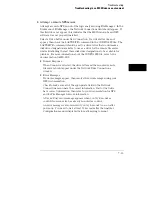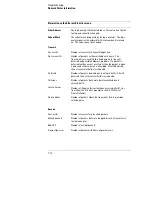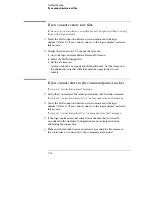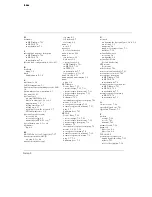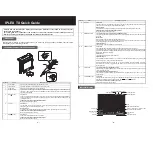
Glossary
benchtop logic analyzer
A small,
standalone logic analyzer that is not
part of the Agilent Technologies
16500 logic analysis system.
client
A computer or program that
is configured to use services pro-
vided by another computer on a
network. Agilent Technologies logic
analyzers do not have client capabili-
ties.
Ethernet
A network that adheres
to the IEEE 802.3 Local Area Net-
work standard.
Ethernet Address
A hexadecimal
number which is used to identify a
machine on a network. Each logic
analyzer is assigned a unique
Ethernet address.
ftp
(File Transfer Protocol) A
service that allows you to remotely
transfer files among different operat-
ing systems.
host
A computer on a network.
When controlling the logic analyzer,
your computer is considered the
host.
host name
A unique name that is
used to identify each host machine
on a network. The host name is cre-
ated by the user or system
administrator.
IP Address
(Internet Protocol Ad-
dress) A unique number that is
assigned to a each device which is to
be connected to a TCP/IP network.
Before using your logic analyzer on a
network, you or your system adminis-
trator will need to assign an IP
address.
mount
The method used in NFS
and other network protocols to gain
access to a network’s resources.
UNIX systems use a "mount" com-
mand. DOS systems typically use a
"net use" command.
NFS
(Network File System)
A distributed file system that allows
data to be shared by computers on a
network, regardless of operating sys-
tem, network architecture, or
protocol. The NFS protocol also al-
lows you to move files between
networks and operating systems.
ping
A utility that allows you to
determine the status of the connec-
tions between devices and a
network. The ping utility is usually
included with software packages that
provide NFS services.
protocol
A set of conventions that
specify how information will be for-
matted and transmitted on a
network, and how machines on a net-
work will communicate.
Glossary-1
Summary of Contents for 1660 CS Series
Page 7: ...1 Connecting and Configuring...
Page 16: ...1 10...
Page 17: ...2 Accessing the Logic Analyzer File System...
Page 25: ...3 Using the X Window Interface...
Page 37: ...4 Retrieving and Restoring Data...
Page 50: ...4 14...
Page 51: ...5 Programming the Logic Analyzer...
Page 64: ...5 14...
Page 65: ...6 Concepts...
Page 72: ...6 8...
Page 73: ...7 Troubleshooting...
Page 104: ...Index Index 4...

